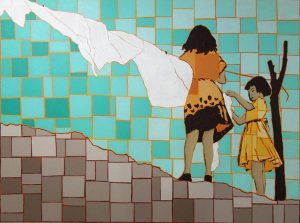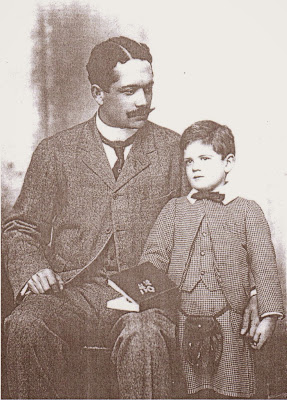Dr Charlie Hall (University of Kent)
Research Administrator, ‘Beyond the Spectacle’
I joined ‘Beyond the Spectacle’ in mid-September as Research Administrator, having been awarded my PhD in History from the University of Kent in January 2017. While my own research interests are primarily in science and technology in Cold War Britain, the project has given me scope to branch out into other areas, and I am currently researching the racial factor in US and Canadian troops who were stationed in Britain during the two World Wars. Alongside these research pursuits, the role of Research Administrator entails a wide range of tasks from handling project finances to running the social media accounts, from making travel arrangements to taking the lead on the project’s digital mapping objectives. I am based at the University of Kent and therefore work particularly closely with the project’s Principal Investigator here, Professor David Stirrup.
As the rest of our team is scattered across the UK and North America, we rely heavily on email and virtual conferencing software to keep in touch. Monthly team meetings conducted via Skype have provided a useful thread to keep all six team members up to date with each other’s research, while also maintaining a truly collaborative spirit (some of this research is highlighted elsewhere in this blog). In this post, I will highlight a few key areas in which the project has made significant progress since September, and signpost elements which we intend to pursue more actively between now and April.
Public Awareness
One of the core intentions of the project is to move away from previous London-centric approaches to Native travel to Britain, and explore the impact these visitors had across the British Isles. In order to obtain a local perspective on a nationwide scale, it is essential that our project is widely publicised and accessible to people beyond conventional scholarly networks. We have therefore fostered public awareness through social media, including this blog, and also through more conventional methods, with the aid of the Press Offices at the Universities of Kent and East Anglia.
One example of how information, and entirely fresh angles, can emerge from the unlikeliest places occurred less than a day after our first press release was disseminated. We received an email from the editor of Golf Course Architecture magazine, who had apparently received our press release in error, but who nonetheless had a story to tell. In the process of research on his own side-project – a biography of golf course architect Matthew Colt – he had come across details of the life of Dr Matthew Puakahakoililanimanuia Makalua, the first Native Hawaiian to study Western medicine. Makalua had come to Britain in the 1880s, studied at King’s College, London, and then married an Englishwoman (Annie Dewar – Colt’s wife’s sister).
Both families ended up settling in Hastings where Dr Makalua ran a successful medical practice and joined his brother-in-law in becoming an avid golfer. He died in Hastings and is buried there. This fascinating story not only reveals the sheer diversity of narratives which surround Native North American presence in Britain, but also the fact that these stories can arise from the most unusual sources. It has certainly encouraged us to consider opening up a Hawaiian research strand where previously it was not an area which we had envisaged pursuing directly. Truly a serendipitous course of events!

Art and Outreach
Integral to the objectives of ‘Beyond the Spectacle’ are a series of residencies which will see Native North American artists, writers and performers each live in the UK for a month to collaborate closely with the project, while also creating and displaying their own work. In this way, the project will develop its own legacy by continuing the very patterns of Native North American presence in Britain which we seek to document and examine.
The first of these residencies will take place in May-June 2018, and will see Marla Allison, a Laguna Pueblo artist, travel to the UK where she will be based in Bristol. This residency is being organised in close collaboration with Rainmaker Gallery, the UK’s foremost Native American art gallery. Jo Prince, Rainmaker’s founder and owner, regularly brings Native artists to Bristol to discuss their work and deliver talks and lectures while their art is being exhibited in her gallery. Marla Allison’s month-long residency will extend this practice, enabling her to engage with some of the research findings of the project, create new work, and interact with the local community, as well as benefit from a solo exhibition at Rainmaker Gallery. Working with a partner such as Rainmaker Gallery is of enormous benefit to the project because of its public reach and established networks, which will enable Marla Allison’s residency in Bristol to have a real impact across a wide variety of fields.
Furthermore, during her time in the UK, Marla, along with members of the project team, will go into schools in Bristol to teach the students about Native American art and culture and develop future teaching materials. She and the team will also to work to uncover the heritage of Native American presence in Bristol throughout history. The Bristol Museum is also offering its support and facilities to this residency. Here, Marla will have a studio space which will be partly accessible to the public.

For more on this work, click here.
Mapping
Another key element of ‘Beyond the Spectacle’ with which I have been closely involved since September is the mapping initiative. Alongside conventional publications and the outreach work mentioned above, one of the project’s main outputs will come in the form of online, virtual, interactive maps which will provide dynamic, visual representations of the history of Native North American presence in Britain, over the past 500 years. At the moment, we are getting to grips with the software available, thanks to the abundant expertise within the University of Kent’s Information Services team, and trying to ascertain which will be the most effective for our purposes.
Our other main effort at this time is to decide exactly what kind of maps we want to produce and what services and information they will offer to users. Making this more complex is the fact that we want our maps to be of value to a wide range of users, not only as a research resource for scholars, but also as a way for groups and individuals, both in Britain and in the Native North American community, to trace those narratives which may link directly to their ancestors.
Some maps will therefore show many routes across the Atlantic over a lengthy time period while others will drill down into specific localities, to examine sites of significant Native American presence in Britain. For instance, we will map out virtual walking tours. In this, our International Collaborator, Professor Coll Thrush (and especially his recent book, Indigenous London), has given us a valuable model through his tours of locations in the capital. This mapping work will generate a unique perspective on Native North American travel to, and residence in, Britain. It will show both global scale and a truly intimate level of local detail.

Moving Forward
With the topics explored above in mind, we have identified clear goals to achieve in the spring term. The first is to utilise the extensive reach of public awareness (through social and more conventional media channels) to develop a crowdsourcing programme, which will involve members of the public sharing their stories, images and material items (and those of their families and ancestors) which relate to Native North American presence in Britain over the past 500 years. In this, we aim to generate a broad understanding of the impact which Native North American travellers and residents had on individuals, families and communities across Britain, and the legacies of their presence which still endure to this day.
In addition, as the project establishes a larger footprint, it brings us into contact with a wider number of other researchers working on areas which coincide to varying degrees with our own primary topics. This has allowed us to build a network which will no doubt outlast the project itself and serve as both a vital resource and an intellectual community for scholars working on the subject of Native North American presence in Britain in the future. Indeed, this collegiality has paid dividends already, for example in the form of external contributions to this blog (see Cecilia Morgan’s post from December). In working to encourage this network, we will continue to liaise closely with those working on allied areas, support their research where possible, and share our findings as and when they become available.
Ultimately, the largest, most visible outcome of the project in its first year will be the artist residency and symposium in Bristol in May-June. As such, continuing to work closely with Rainmaker Gallery, the Bristol Museum, local schools, and other relevant organisations will form a central part of our efforts in the spring term. This will include developing a solid programme of speakers for the symposium, more detailed planning for the public engagement and education work, and publicising the residency and all associated events to ensure it has the biggest possible reach, ready for when it begins in May.
On the whole then, ‘Beyond the Spectacle’ has got off to a flying start. We have been thrilled with the positive reactions we have received from all sectors, be it amateur local historians, journalists, academics, artists, collectors, curators, archivists, representatives of Native communities, and members of the public, both here in Britain and abroad. We are also very encouraged by the number of avenues of research which have opened up since September, and while we are not in a position to pursue every one of these sub-topics (as we focus in greater depth on a smaller range of areas), we are always keen to encourage and support other scholars to do so. The project having now found its feet, we will be able to move forward with greater confidence throughout the spring term, and another update from me will be forthcoming in April, by which stage I am sure we will all have plenty more of interest to report.

